|
January 10, 2017
We went for a walk on the beach in
the morning, turning left and going almost down to the far point.
As usual the pelicans were out - I never tire of watching them.
They would fold their wings and rocket straight down into the
water, and then float on the surface, a bit ungainly, while
chugging down the fish they had caught. On the way back we met
Richard, out walking the beach with three of the dogs. We stopped
to chat a bit; he pointed out that the rocky island near the point
was shaped like a sleeping lion (see photo above).
|
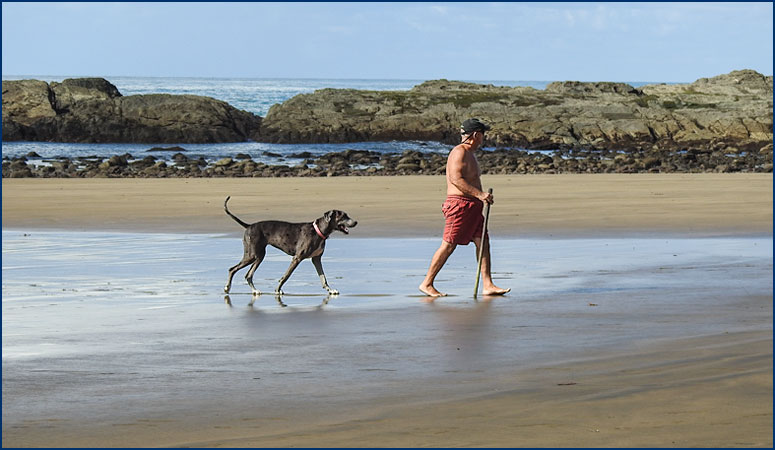
Richard and his
loyal friend.
|
We went back to
Hacienda Baru and had breakfast there. We stopped by the little
shop at the office and Jineen was delighted to find they had a
book exchange; she picked out a mystery, looking forward to having
something to read that night.
We then visited the bird tower,
the butterfly garden and the orchid garden, but found all three a
little disappointing. However we did have good luck in the parking
lot; there was a lovely sloth in a tree (not moving, of course),
and a toucan lit on a branch above us, looking like something
straight off of a Fruit Loops box.
|
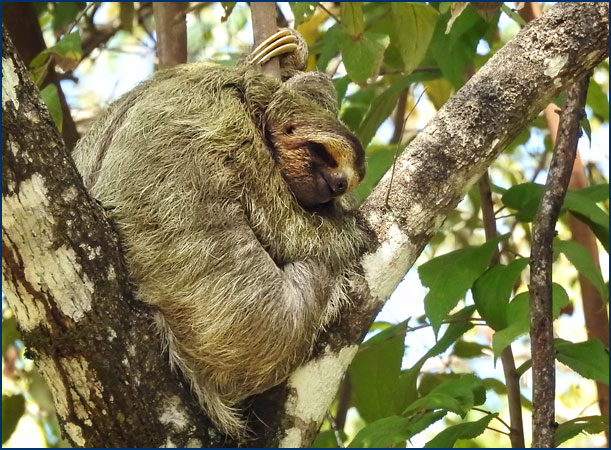
Three-toed Sloth,
napping as usual. |
We drove back
down through Dominical and visited the shops. Along the beach
there was a long row of vendors who set up little stalls selling
gifts and touristy trinkets. Some were nice quality locally-made
items, but a lot of the merchandise appeared to be cheap junk from
China or India. After all, why would products made in Costa Rica
have elephants on them?
|
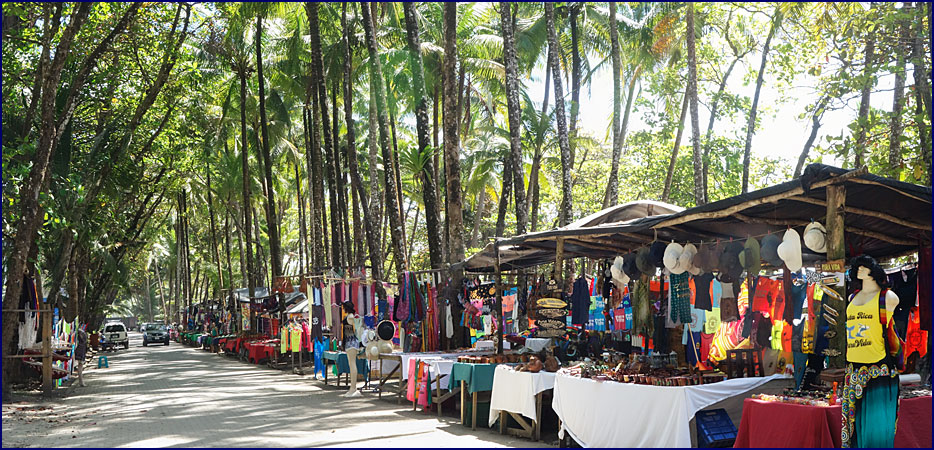
Shopping in
Dominical
|
In the afternoon
we visited the Altrusa Wildlife Sanctuary, a rescue facility
associated with a lodge. They rehabilitate animals and birds that
have been injured or orphaned, and if possible reintroduce them to
the wild.
As we turned up their road there
was a sign that said four-wheel-drive only, and indeed it was
quite steep up to the lodge, which sat high on a ridge looking
down over the ocean. We met up with the guide for the one o'clock
tour. He led a group of about twenty of us through the rehab
facility, telling us about the different rescue animals and
explaining how they were cared for. Many of the animals had been
found orphaned or injured in the wild, but a lot of them had been
confiscated from people who were illegally keeping wild animals as
pets.
There were large cages that housed
the different birds and animals, some together in groups and some
individually, depending on their needs. The guide led us from cage
to cage. There were macaws, parrots, toucans, hawks, and owls.
Several baby two-toed sloths slept in a hanging basket,
intertwined with each other, not moving. A large walled enclosure
in the middle of the compound held a coati, two raccoons, and an
anteater – but unfortunately the anteater, being nocturnal, was
sleeping inside a den so we couldn’t see him. Disappointingly,
this was also the case with the porcupine and the kinkajou.
There were several large cages
housing capuchin and spider monkeys. This made me immediately
remember why I did not like monkeys in the past; their behavior in
captivity was completely different from the lovely creatures we
had observed in the bamboo forest. One of the capuchins would
cleverly reach out and try to open the door latch, which had been
bolted shut due to earlier escape attempts. But another was very
aggressive, throwing gravel at us through the chain link cage, and
leaping at us screeching in an attempt to scare us into jumping
back. Our guide told us that the spider monkeys were so aggressive
that the handlers could not go in the cages with them at all.
These monkeys had all been confiscated from people who had them as
pets in abusive situations, so it would not be possible to
reintroduce them to the wild. It was very sad.
|
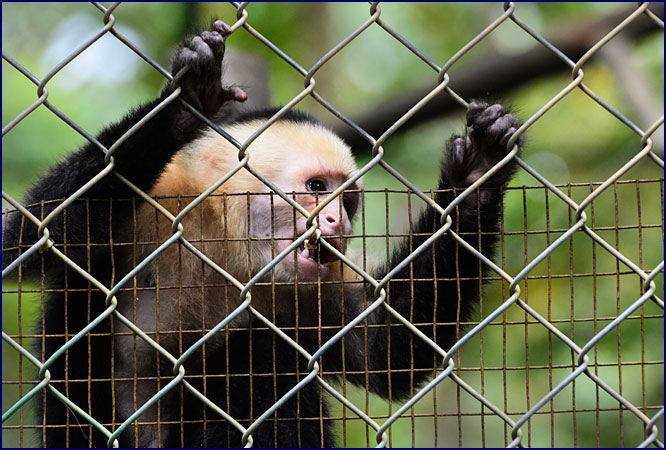
Wild animals should
not be kept in cages as pets. |
The wildlife
sanctuary does good and necessary work, but seeing these wild
animals in cages was a little depressing. I felt good about the
ones that were being rehabilitated and would be returned to
nature, but the others were a clear example of why wild animals
should not be captured and kept as pets. They belong in the wild,
not in a cage! Probably the highlight of the tour was watching a
toucan perched in a tree above one of the cages; he had been
recently released to the wild, and his mate, who was still in the
cage, would be released quite soon as well.
|
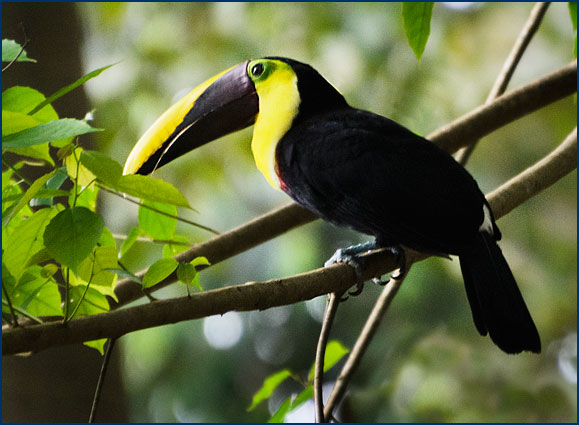
Mr. Froot Loops |
Back
at Coconut Grove we ate mango and avocados for lunch, and saved
the pineapple for another day. The fun little Nellie-dog hung out
on the porch, mooching for handouts. While Jineen studied the bird
guidebook trying to identify some of the types we had seen, I went
for a walk around the grounds. The kiskadees were dipping in the
pool again, and iguanas roamed the lawn. I spotted a mangrove
black hawk perched on a low limb; he stared regally back at me.
There was a pond next door that Richard had said contained
alligators; I wanted to check it out to see if he was just pulling
our leg, but the grass was tall and I was wary of snakes.
|
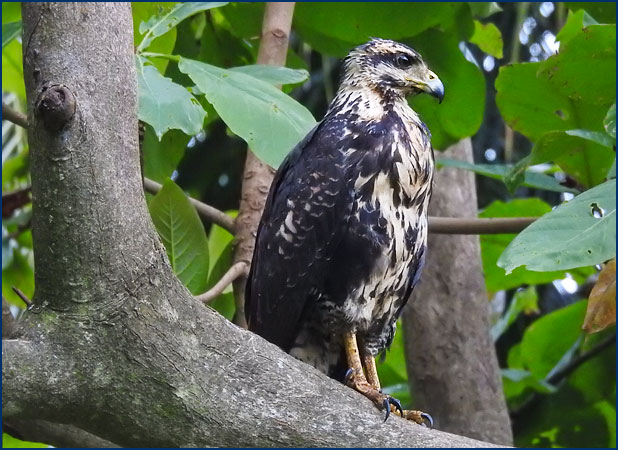
Mangrove Black Hawk,
juvenile. |
Soon it was time
for our afternoon swim. Jineen and I spent over an hour and a half
in the water, savoring our last afternoon in the ocean, rolling
with the waves and ducking the breakers. The pelicans were diving
quite close to us, seeming to come up with a fish every time. The
couple in the cabin next door came out to do a bit of surfing, she
on a boogie board and he on a small surfboard – they were not
very proficient but did seem to be having fun. Five para-gliders
sailed overhead, following the shoreline while riding high on the
thermals.
We got out of the water a
little while before sunset. We sat on a rock on the beach and
drank some wine, and watched as the sky filled with color and the
sun sank into the Pacific. With this amazing setting, our close
friendship and great conversation, it was one of the best happy
hour’s ever.
|
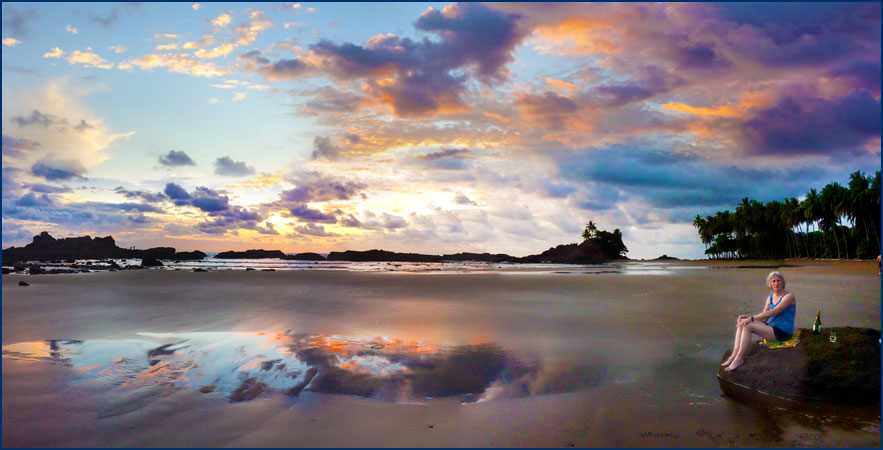
Happy Hour |
A rainstorm blew
up, the first we had encountered on the trip; soon it was pelting
down hard. Since the remote control for the gate had not worked
the previous evening, before heading out for dinner I phoned Diane
to be sure we could get back in later. Our call got cut off in the
storm, and a few minutes later Richard showed up at our door in
the pouring rain to bring us their personal gate controller. We
felt terrible!
We drove down to the town of Uvita,
which ended up being a little further than we had anticipated; it
was very dark and the rain was still coming down hard. We went to
a new restaurant called Kaku, which proved to have excellent
seafood and exceptional piña coladas. We were tired, and the
drive home seemed very long. Finally we turned into the driveway,
pressed the remote to open the gate, and – nothing happened.
Once again, we could not get the gate to open. We pressed every
button on the device, pointed it in every possible direction and
tried it from all angles – but nothing. Again we had to phone
Diane and Richard, very sheepishly, and explain that we couldn’t
make the gate work. They must think we are incompetent idiots!
Getting ready for bed, Jineen made
the discovery that the book she had gotten at the shop earlier was
in Spanish. Damn! The title on the cover was in English, and she
had never thought to look inside. She went to bed reading the
tourist advertisement brochure she had picked up at the
restaurant.
January
11, 2017
Jineen and I went for a last walk
on the beach. We walked past the sleeping lion island and up a
little lane to a restaurant Richard had recommended for breakfast.
We sat watching the surf crashing against a rocky island and ate
banana-caramelized French toast with coconut syrup, with a side of
fried plantains. It was absolutely out of this world. Stuffed, we
waddled back to our cottage.
We said goodbye to Richard and Diane. We
were sad to be leaving Coconut Grove; we had really gotten
attached to this place in just a few days. I would go back in a
heartbeat! One meets
people who come on vacation to some tropical paradise like this
and then just never leave; I could really understand how it could
happen.
|
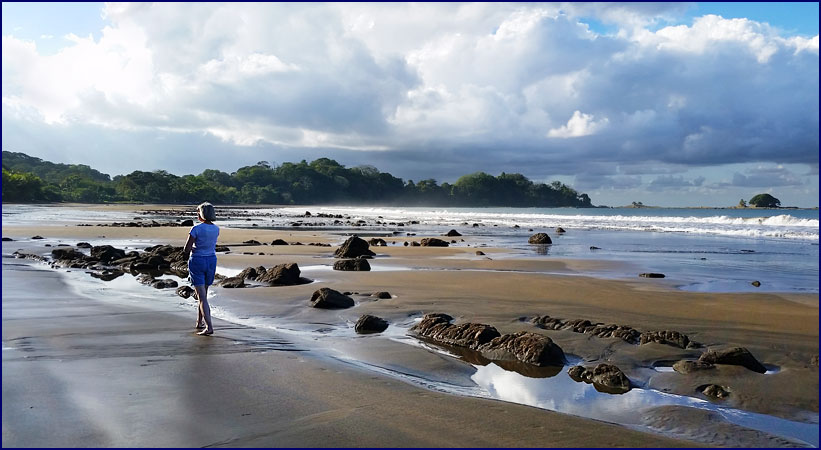
Paradise |
We drove north,
following the shoreline. We stopped briefly at Playa Hermosa and
watched the pelicans and surfers. We passed huge plantations of
coconut trees, stretching as far as the eye could see. The posts
of the fences alongside the road were made from living trees, cut
back to size. We drove by a restaurant that I recognized, having
eaten breakfast there on my previous trip to Costa Rica. I
remembered our guide had taken us to see scarlet macaws in a grove
of almond trees nearby; now if I could only remember how to find
it!
We stopped beside the Tarcoles
River, parked the car, and walked out over the long bridge.
Looking down, we could see a large group of crocodiles on the
riverbank below; there must have been at least fifty of them. They
were huge and somewhat evil looking.
|
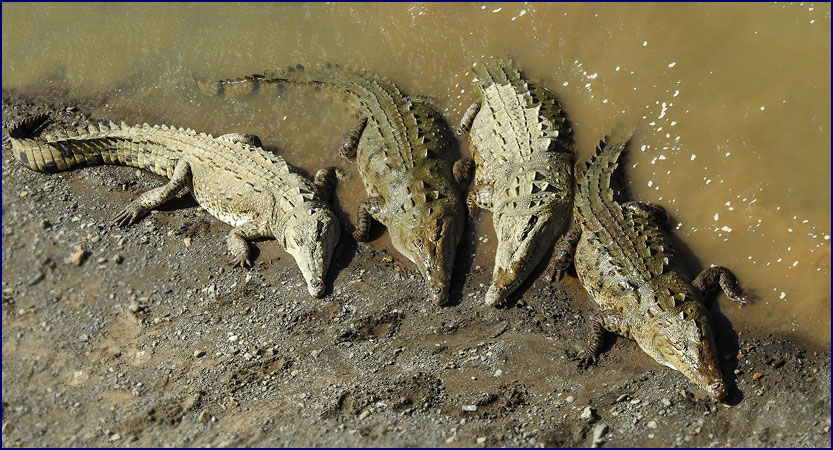
Crocs under the Tarcoles River Bridge. |
We arrived at
the Cerra Lodge in the early afternoon. It would be our last night
in Costa Rica, and we were really hoping to see macaws, one of the
last things on our wish list. When we checked in the resident
guide told us these birds would be hard to miss - they are large,
brightly colored, and make a lot of noise. As we were carrying our
bags to our cabin we heard a loud raucous squawking, and half a
dozen scarlet macaws flew past overhead. Well, we didn’t have to
wait long for that!
|
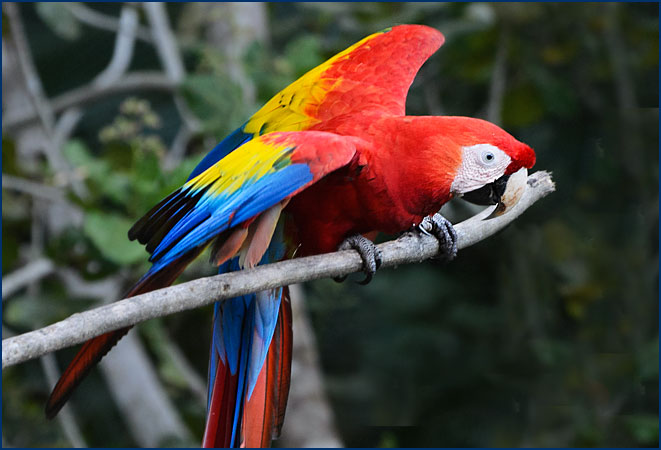
Scarlet Macaw |
After dropping
our stuff at the room we went back up to the open-air restaurant
to check out the view. We found the six macaws eating at a special
feeder, quite close to the balcony. After a while they flew up
into a nearby tree for a bit, before flying away. They were
absolutely incredible! These huge parrot-like birds are a
brilliant scarlet color with bright blue and yellow wings. They
look too flamboyant to be real.
|
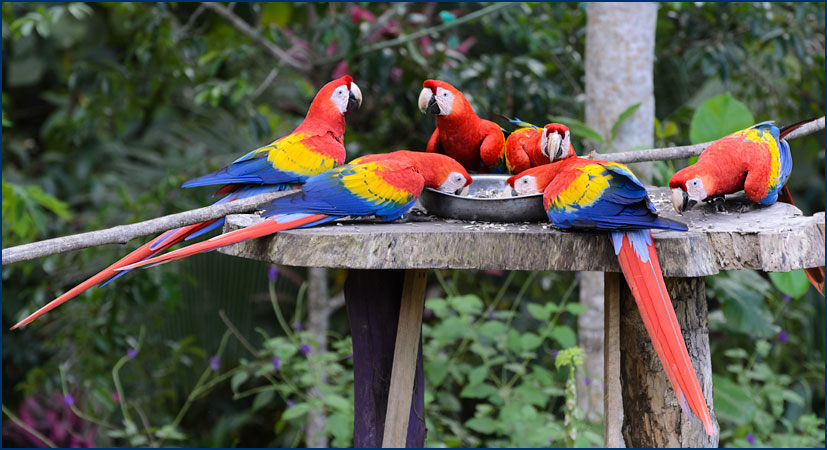
Macaws at the
feeder. |
There
were several feeders near the balcony, where one could sit in the
restaurant and watch the different birds came to eat. The
clientele of this lodge consisted mainly of birders, and they
gathered to identify the different species. There were a good many
birds we had not seen before; a new woodpecker, several types of
kiskadees, a lovely blue-grey tanager and many brightly colored
vireos. There were quite a few of the clay-colored thrushes, the
national bird of Costa Rica. I got a photo of a small milky-green
bird that we are still trying to identify. Consulting Jineen’s
notes, we counted up that we had seen nine different types of
hummingbirds on the trip.
|
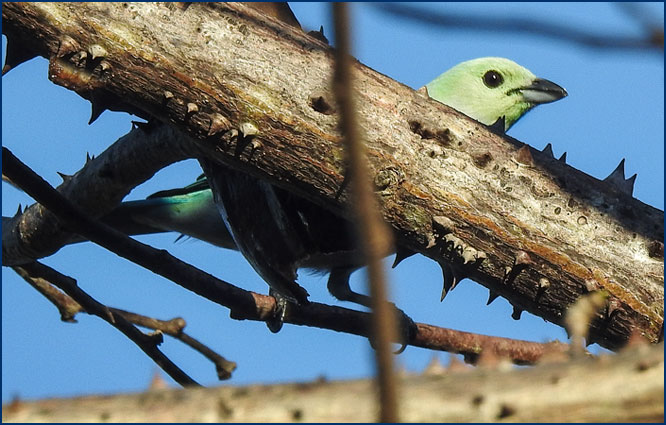
Our little green
Mystery Bird. Anyone know what kind this is?
|
We drove down
the little gravel lane past the lodge to the bottom of the valley,
exploring. It was actually considered a birding trail, but we
didn’t want to have to hike back up. We came to a big farm with
fields of cattle and horses, and stopped to admire several
impressive Brahma bulls in a field beside the road. They were
huge.
|
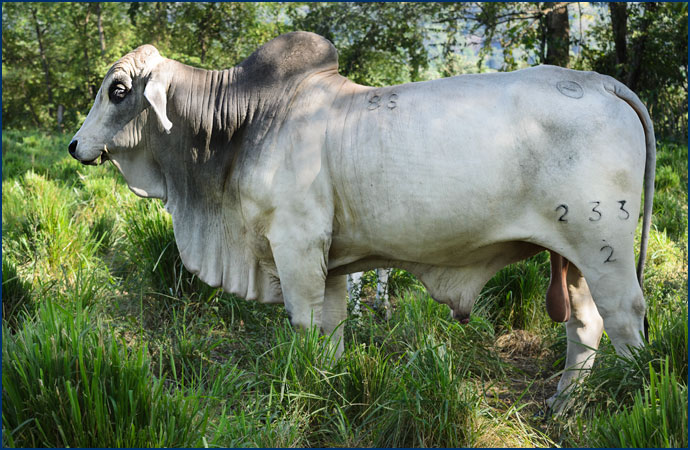
Brahma Bull |
We went down to
the very end of the road and parked the car; it seemed the
Tarcoles River must be near. We climbed over a metal gate and made
our way across a field, hoping there were no bulls in it. We came
to the remains of an old building, with little left but a cement
foundation and the remnants of a bathroom. A grove of large trees
grew there, providing shade and solace. A pair of Inca doves
perched on a limb; with delicate lacelike edging on their feathers
and russet brown on their wings visible in flight, they were one
of my favorites for the trip. I thought Inca Dove would be a good
name for a horse, and sure enough, after returning home I bought a
pretty Thoroughbred mare and named her that.
|
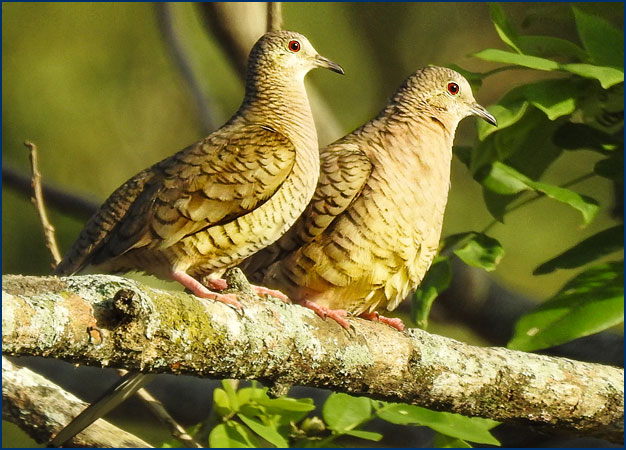
Inca Doves |
We crossed a
floodplain, following little paths through the high weeds and
brush. We came to a barbed-wire fence and on the other side, about
twenty feet below us, the Tarcoles River flowed lazily. Two large
crocodiles lurked on the far bank. A great blue heron waded in the
water, and several egrets stood nearby. Looking up the river, we
could see the road and the crocodile bridge in the distance.
|
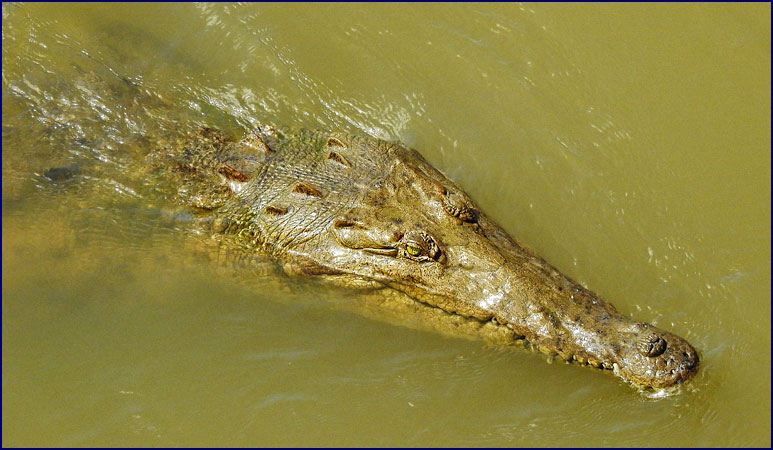
Denizens of the
Tarcoles River.
|
We
made our way back to the old foundation - it seemed a peaceful
place. We puttered around under the shady trees for a little
while. I wondered about the building that had once stood here,
letting my imagination roam. Was it a house? Who had lived in it?
Surely some family in days gone by had appreciated the beauty of
this spot.
|
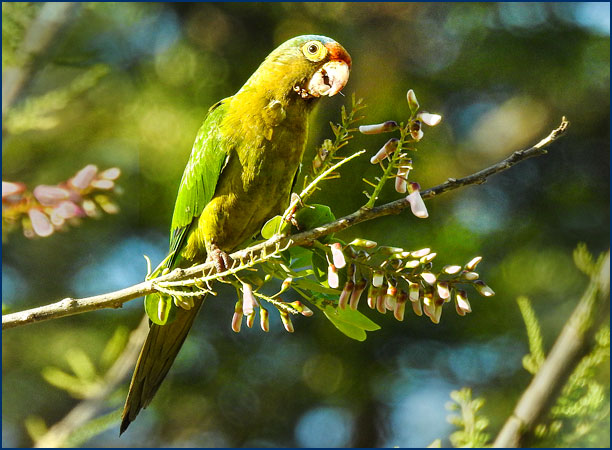
Orange-fronted
Parakeet |
Then
the parakeets came. Four of them flew in and landed in a tree
beside the foundation. They were orange-fronted parakeets,
beautiful green birds with red above their beak, a slightly orange
upper breast, and a white ring around their eyes. They sat in a
small tree eating the flower blossoms, and I was able to slowly
creep quite close to them. This was just about my last wish for
the trip - to get close enough to parakeets for photos. It was
lovely watching them.
|
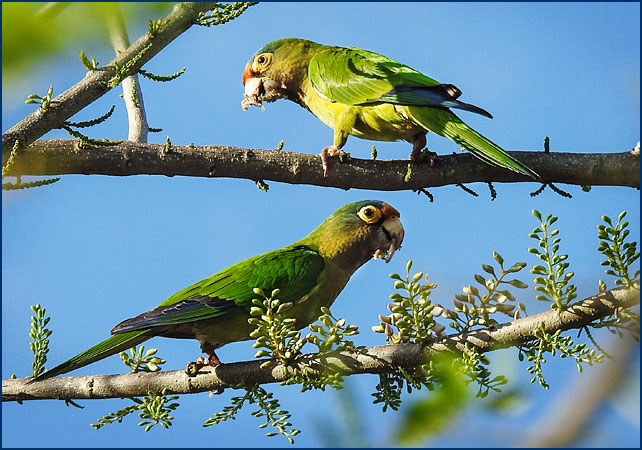
The parakeets dining
on flower blossoms. |
We drove back up
the hill toward the lodge, dodging the birdwatchers that were
setting up their scopes in the roadway, and stopped at a spot
where we could look down across the river valley. We had happy
hour, sipping wine and watching the sun set. The Tarcoles River
snaked through the floodplain below like a silver ribbon. A full
moon topped the horizon behind us. We had purchased a tiny knife
earlier, and Jineen did an excellent job of carving up the
pineapple, which proved to be delicious.
|
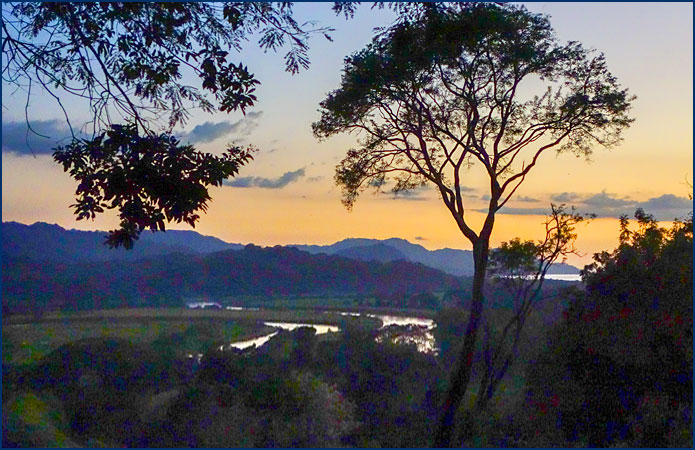
Happy Hour looking
down over the Tarcoles River valley. |
We watched two
large birds of prey fly in and perch on the top of a dead tree,
silhouetted against the dusky sky. Consulting the bird book,
Jineen identified them as crested caracaras. It was a beautiful
evening. After a while the mosquitoes started coming out in droves
so it was time to go.
During dinner at the lodge we
could hear howler monkeys raising a ruckus - they had deep barking
voices that sounded like big mean dogs. We noticed that the noises
seemed to be coming from the direction of our cabin.
We went back to our room to
organize our luggage and pack for the trip home. The room was a
little unusual, with a décor in an unsettling deep orange color.
The bathroom was outside; one went through a door into a
semi-circular walled-off area with plants and shrubs, open to the
sky. While using the facilities, Jineen was startled by a large
frog that jumped off the back of the toilet, climbed up the wall,
and disappeared behind the vanity mirror.
Several times during the night we
heard loud scuffling sounds, like something scratching at the
bathroom door trying to get in. Each time we opened the door to
look there was nothing there, so we figured whatever it was must
be on the roof. We briefly wondered if it might be those howler
monkeys, but decided it was more likely a squirrel.
January
12, 2017
We were up early; the beds were
too uncomfortable to sleep longer anyway. We went to the
restaurant balcony to see if the macaws were around; they
weren’t, but we tarried a while watching other birds at the
feeder.
We heard the guide telling one of
his clients that there was a pacific screech owl in a tree nearby,
so when they went to see it we shamelessly followed them.
|
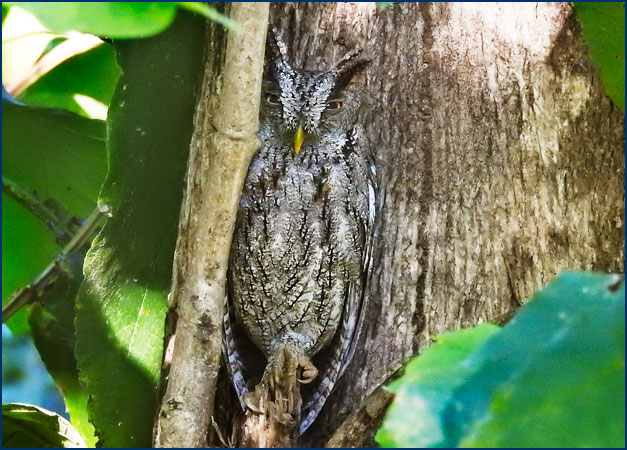
Pacific Screech Owl, perfectly camouflaged. |
Just below the
cabins, we found the owl sitting in a shallow hole in a tree, flat
up against the trunk. Surprisingly it was only about four feet off
the ground, but it was very well camouflaged. We gazed at it and
it stared back at us, seemingly undisturbed by our presence. A
second owl, presumably its mate, sat a bit higher in the tree,
harder to see.
|
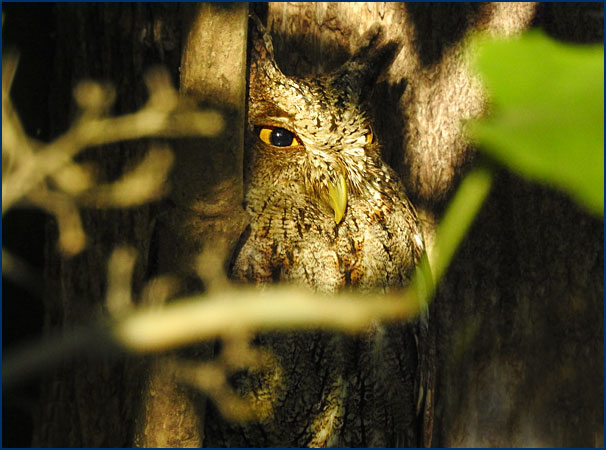
Wise dignity.
|
We heard a
screeching overhead - two of the macaws had come back. They
visited the feeder for a few minutes before flying up to the top
of a big tree near the path. We watched them for a while, and then
they took off, swooping past our cabin and disappearing into the
forest.
It was time to leave paradise. We said goodbye to Cerra Lodge and
drove to the airport.
|
~
The End ~
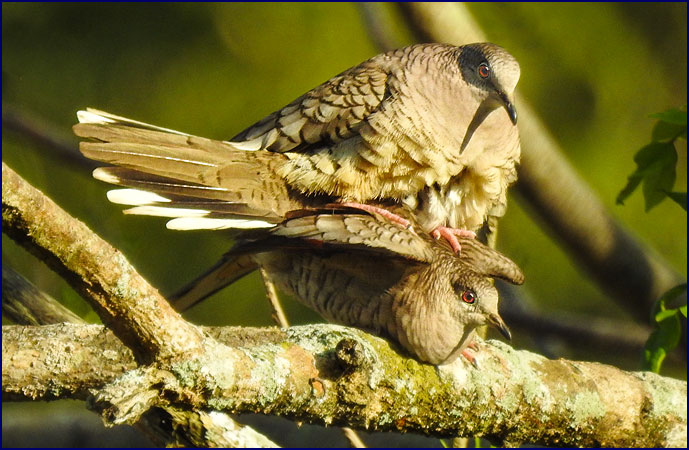
Bonus Material: a little Inca Dove
hanky-panky.
Costa
Rica Pages: Next
1
2
3 4
|
|